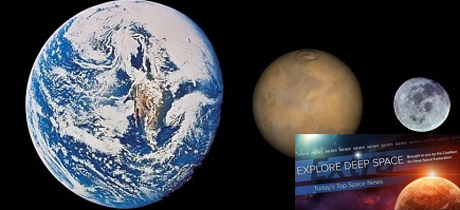In Today’s Deep Space Extra… Trump hails Mars as NASA’s next target. Australia Plans to join with NASA in the exploration of the Moon and beyond. Hope for restoring communications with India’s Chandrayaan-2 Moon lander fade.
Human Space Exploration
Trump hails Mars as NASA’s next target, says the Moon’s ‘not so exciting’
Space.com (9/22): U.S. President Donald Trump on Friday offered an assessment of NASA’s efforts to achieve an accelerated human return to the surface of the Moon by 2024. “‘Hey, we’ve done the Moon. That’s not so exciting,” said Trump “so we’ll be doing the Moon. But we’ll really be doing Mars.” The president spoke after meeting with Australia’s Prime Minister Scott Morrison on future deep space cooperation between the two countries.
Australia will help NASA go to the Moon and Mars
Engadget (9/21): Australia intends to commit $150 million over five years to join NASA led efforts to explore the Moon and Mars with contributions in the areas of robotics, automation, remote asset management.
NASA joins last of five sections for Space Launch System (SLS) rocket stage
Coalition Members in the News – Aerojet Rocketdyne, Boeing
NASA (9/19): Assembly of all five elements of NASA’s Artemis-1 Space Launch System (SLS) rocket core were completed at the Michoud Assembly Facility in New Orleans last Thursday. Artemis-1 is to send an uncrewed Orion capsule around the Moon and back to Earth over a multi-week test flight to be followed by a crewed repeat called Artemis-2. The first two test flights are to be followed by Artemis-3, a return to the lunar surface with human explorers in 2024. The Artemis-1 core, developed by Boeing, is to be equipped with four Aerojet Rocketdyne rocket engines this fall and prepared for a “Green Run” full duration test firing at NASA’s Stennis Space Center in nearby Mississippi.
2024 Moon landing deadline is definitely political and aspirational but that’s not all bad (Op-ed)
The Hill (9/19): Deadlines, such as NASA’s 2024 finish line for an accelerated return of human explorers to the surface of the Moon, has important benefits to consider, according to an op-ed from Ryan Faith, a space policy consultant. On the political front, deadlines are a symbol of achievement for supportive lawmakers before their terms in office expire. On the technical front, deadlines are forcing functions that tell engineers to concentrate on the most critical details of an objective.
Designing a Moon suit for the 21st century
Air and Space Magazine (October): As it prepares for an accelerated 2024 return to the surface of the Moon with human explorers, NASA and its contractors are addressing a range of space suit challenges, including greater mobility, endurance, more flexible sizing, enhanced communications and shielding against Moon dust intrusion.
Space Science
The final call: ISRO makes last attempts to connect with Chandrayaan 2’s Vikram Lander before lunar night falls
ZeeNews of India (9/21): A lengthy night fell across the target landing zone for India’s Chandrayaan-2 lander on September 21, dashing hopes of locating the solar powered lander and a companion rover, with which communications was lost during the final minutes of an automated powered descent on September 6, U.S. time. The Vikram, Pragyan lander/rover combination were designed to explore the cratered south pole landing site in sunlight conditions for two weeks after touchdown.
India’s Chandrayaan-2 marks 60 years of Moon crashes and hard landings
New York Times (9/20): In all, seven countries or organizations have crashed spacecraft at the Moon, beginning with the former Soviet Union’s Luna 2 in 1959. An earlier Soviet mission, Luna 1, missed its destination, the Moon, altogether. Mars is no easier, and though it’s had its spacecraft casualties, NASA is the only space agency to have succeeded in landing multiple times, most recently with Mars InSight in late November 2018.
A “sneaky” asteroid narrowly missed Earth this Summer. Internal emails show how NASA scientists totally missed it
Buzz Feed News (9/19): A July incident involving the asteroid 2019 OK, which sped close by the Earth at a distance of 40,400 miles just 24 hours after it was detected illustrates the potential threat posed by near earth objects. 2019 OK, estimated at 57-130 meters in diameter, was moving at 55,000 miles per hour.
Other News
’Ad Astra’ is an astronaut adventure with soul, and its brightest star is Brad Pitt
Washington Post (9/20): Ad Astra, which opened in theaters last weekend starring Brad Pitt, draws comparisons in significance to 2001: A Space Odyssey.
Major Space Related Activities for the Week
Major space related activities for the week of September 22-28, 2019
Spacepolicyonline.com (9/22): As the start of the 2020 federal fiscal year approaches on October 1, Congress has yet to come together on a budget and will need a continuing resolution, or CR, if lawmakers are to avoid a shutdown. The House has passed a CR effective through November 21, which would continue spending at 2019 levels, a difficulty for NASA’s efforts to accelerate a return to the surface of the Moon with human explorers in 2024. Also this week, Japan plans to launch a cargo mission to the International Space Station (ISS). Russia plans to launch U.S. and Russian crew members to the Space Station. They will be joined by the first astronaut from the United Arab Emirates (UAE).

